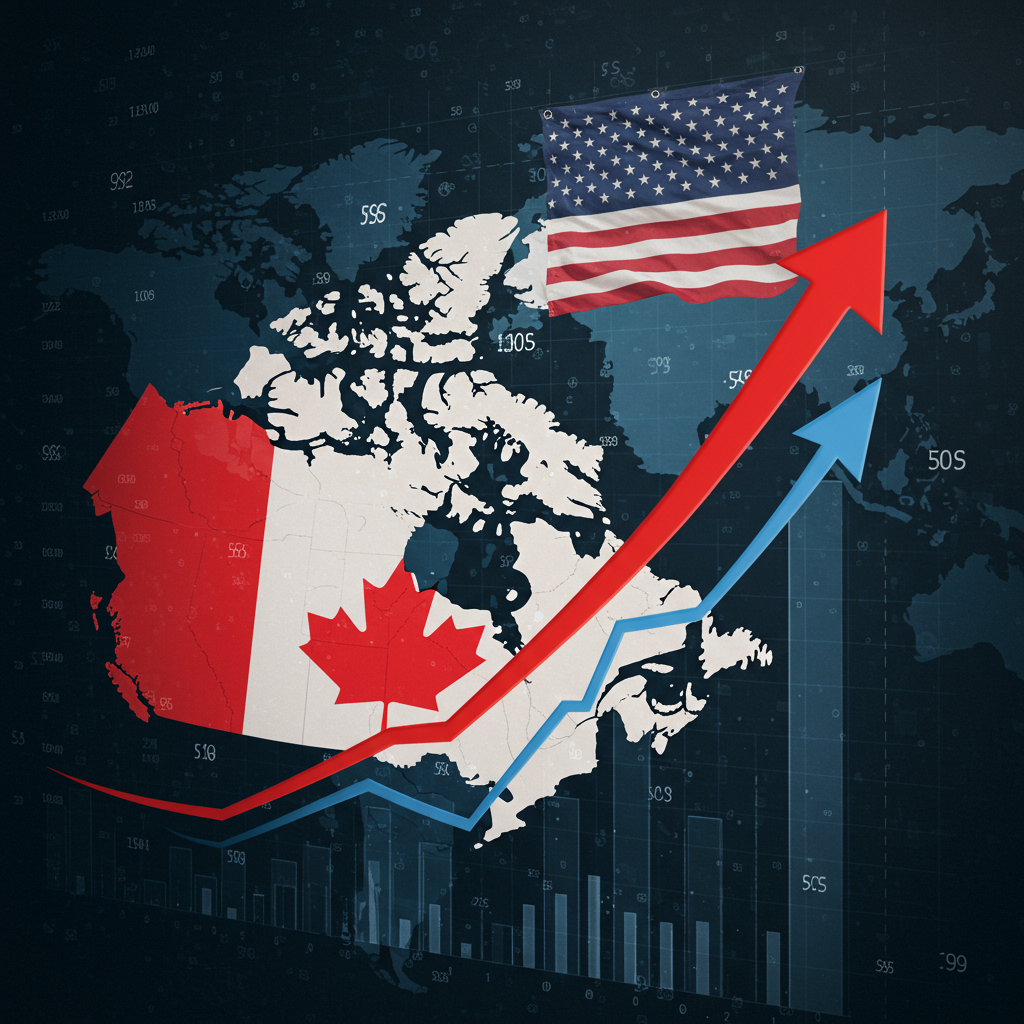canada’s economic forecast for the current year has received a cautious upgrade from leading economists. This revised outlook emerges amidst a complex and shifting global trade landscape, where certain tariff threats may be easing, but new uncertainties are simultaneously arising, particularly concerning relations with the United States.
Experts surveyed by Bloomberg now anticipate Canada’s economy will expand at a 1.4% annual pace in 2025. This marks an improvement from the 1.2% growth rate projected just last month. At this pace, Canada’s economic performance would potentially rank second only to the United States among Group of Seven (G7) nations.
This subtle but significant upward revision reflects a mix of factors. While trade tensions remain a dominant theme, recent data points from late 2024 and early 2025 have shown unexpected resilience in the Canadian economy. This underlying strength appears to be partially offsetting the headwinds created by unpredictable trade policies, offering a glimmer of cautious optimism for the year ahead.
Navigating the Tariff Landscape: A Mixed Picture
The notion of “easing tariff threats” is not a simple, uniform trend. While some areas of global trade friction might see de-escalation, the situation with Canada’s largest trading partner, the U.S., presents a more complicated picture.
Recent reports indicate significant developments in U.S. trade policy under President Trump. On June 27, 2025, President Trump reportedly announced the termination of trade talks with Canada. He cited Canada’s planned implementation of a digital services tax as a direct provocation. This decision came with a threat to impose new tariffs on Canadian goods within a week, starkly contrasting with news of a solidified trade truce between the U.S. and China announced around the same time. This US-China agreement reportedly set tariff rates and included specific concessions like China agreeing to provide rare earths.
This dynamic environment, where major breakthroughs occur alongside sudden setbacks, creates substantial “tariff whiplash.” Forecasters face difficulty predicting outcomes, leading to wider variations in economic models. The U.S. administration had previously set a July 9th deadline for finalizing trade pacts before a tariff pause potentially expired, although officials later suggested flexibility on this timeline, potentially extending the pause for countries negotiating in good faith. While trade deals with some partners like the UK have firmed up, negotiations with others like the EU and India continue to face roadblocks, highlighting the ongoing global trade uncertainty.
Resilience Despite Headwinds: What the Data Shows
Despite the persistent trade risks, Canada’s economy demonstrated stronger-than-anticipated growth towards the end of 2024. Data from Statistics Canada showed real Gross Domestic Product (GDP) expanded by a robust 2.6% on an annualized basis in the fourth quarter of 2024. This performance comfortably surpassed both the Bank of Canada’s own forecast and economists’ predictions.
This momentum carried into early 2025. Preliminary estimates pointed to continued GDP growth in December and an acceleration in January. A primary driver for this strength was a notable rise in consumer spending, particularly on durable goods like vehicles. Experts link this surge directly to the Bank of Canada’s earlier decision to lower interest rates multiple times throughout 2024. Lower borrowing costs boosted consumer confidence and made significant purchases and mortgage renewals more accessible for households.
Further positive signs included a 2.6% increase in retail activity in December, marking the largest monthly rise in years. The transportation sector also saw growth, recovering from previous labor disputes and benefiting from increased demand. Importantly, Canada’s real GDP per capita increased by 0.2% in the fourth quarter of 2024. This was a notable positive shift, as the economy had contracted on a per-person basis in five of the preceding seven quarters, indicating a potential improvement in individual living standards.
This recent strong performance provides a foundation that helps explain the slightly higher growth forecast for the full year, even as trade uncertainties persist.
The Bank of Canada’s Balancing Act
The complex trade environment significantly impacts the Bank of Canada’s monetary policy decisions. The central bank recently reduced its key interest rate to 2.75%. This move was made specifically in response to the rising uncertainty surrounding Canada’s economic outlook, driven substantially by U.S. tariffs and trade tensions.
Tariffs pose a dual threat: they can increase import prices, potentially contributing to inflation, while simultaneously hindering economic growth by disrupting trade flows and dampening business investment. The Bank of Canada’s rate cut signals its concern about these potential negative impacts.
Looking ahead, analysts suggest that if further trade measures are imposed, the Bank of Canada might feel compelled to implement additional rate cuts to support growth and mitigate economic difficulties. While previously nearing the end of its easing cycle, the renewed trade uncertainty has complicated the path towards a “smooth landing” for the economy. The central bank faces a difficult situation, balancing the need to stimulate growth amid trade fears with the risk of sticky inflation. The market itself remains divided on the timing and necessity of future cuts, reflecting the high degree of economic uncertainty. The Bank of Canada is expected to continue focusing on the impact of trade disruptions on demand and may deliver further precautionary rate cuts as the labor market softens, though persistent inflationary pressures could limit the extent of easing.
Impacts on Businesses, Consumers, and Provinces
The effects of trade uncertainty ripple through the Canadian economy unevenly, impacting different sectors and regions differently.
Business Investment: Uncertainty directly contributes to a pullback in business investment. Companies become hesitant to initiate new projects or make significant capital expenditures when the rules of international trade are unclear or constantly shifting. While some businesses continue with planned investments, the overall climate makes risk-averse behavior more likely, hindering potential growth.
Consumer Spending: Consumers may also become more cautious. Fears about job security, particularly in export-reliant industries like manufacturing, auto production, energy, and agriculture, can lead households to increase savings and reduce discretionary spending in anticipation of potential economic hardship. However, the positive impact of lower interest rates has recently helped counter this caution, fueling the consumer spending surge seen in late 2024.
Industry Variations: The impact is not uniform across industries. Sectors like oil & gas and tourism may see relative strength due to factors like resilient U.S. demand, pipeline capacity, and a shift towards domestic travel or alternative destinations away from the U.S. In contrast, manufacturing, especially automotive and steel/aluminum production, faces significant headwinds from tariffs and uncertainty, leading to layoffs and cutbacks. Other trade-exposed sectors, including transportation and wholesale/retail trade, are also likely to feel negative effects as trade volumes fluctuate and consumer spending patterns shift.
Provincial Differences: The economic outlook varies significantly by province depending on trade exposure and sector mix. Trade-dependent provinces with large manufacturing bases, like Ontario and Quebec, are expected to be most affected by trade disruptions. Provinces with more diversified trading partners or resilient resource sectors, such as Alberta and Saskatchewan, may fare better, although they are not immune to the overall uncertainty. Provinces less exposed to direct tariff impacts or benefiting from specific local factors like construction projects or tight labor markets might experience growth nearer or above the national average.
Broader Economic Context
The U.S. trade policies have wider implications beyond direct US-Canada trade. Increased U.S. tariffs on imports from countries like China are expected to negatively impact the U.S. economy itself, particularly its manufacturing sector. Given the deep integration of the North American economy, reduced manufacturing activity in the U.S. can have spillover effects that also dampen Canadian manufacturing output.
Canada’s retaliatory measures in response to U.S. tariffs have been more targeted. These measures are designed to encourage Canadian importers to find alternative supply sources away from the U.S. While this strategy aims to minimize economic damage, it still increases costs for Canadian businesses importing goods from the U.S.
The unpredictable nature of U.S. trade policy remains a primary factor dampening both consumer and business confidence in Canada. Even if additional tariffs are avoided, the sheer uncertainty makes long-term planning difficult and weighs on investment decisions. The threat of “reciprocal” tariffs targeting perceived non-tariff barriers or domestic taxes (like Canada’s digital services tax) adds another layer of risk.
Moreover, the value of the Canadian dollar has remained relatively steady against the U.S. dollar but has depreciated against other major currencies. While not the most pressing concern, a lower loonie makes imported consumer goods more expensive and increases the cost for businesses purchasing essential machinery and equipment from abroad.
Overall, while recent economic data provided a positive surprise and contributed to the slightly higher full-year forecast, the economic picture for Canada in 2025 remains significantly influenced, and potentially constrained, by external trade risks. The revised outlook reflects a delicate balance between unexpected domestic resilience and persistent international volatility.
Frequently Asked Questions
What is the updated economic forecast for Canada in 2025 and what factors are driving the change?
Economists surveyed by Bloomberg have increased their forecast for Canada’s economic growth in 2025 to a 1.4% annual pace, up from 1.2% previously expected. This upward revision is driven by a combination of factors. Recent data from late 2024 showed stronger-than-anticipated GDP growth and robust consumer spending, partly fueled by earlier Bank of Canada interest rate cuts. While trade tensions remain a significant headwind, this underlying domestic resilience appears to be partially offsetting the negative impacts, leading to a slightly more optimistic forecast for the year’s average growth.
How is the Bank of Canada responding to the ongoing trade uncertainty?
The Bank of Canada has already lowered its key interest rate to 2.75% largely in response to the economic uncertainty created by U.S. tariffs and trade tensions. The central bank views these external risks as potentially harmful to both growth and price stability. Experts anticipate the Bank of Canada may implement further rate cuts, potentially reaching 2.25% by summer, as precautionary measures to support the economy. However, the Bank faces a challenge balancing the need to stimulate growth with the risk of persistent inflation.
Which Canadian industries and regions are most likely to be impacted by U.S. trade policies?
Industries heavily reliant on exports to the U.S. and facing specific tariffs are most vulnerable. Manufacturing sectors, particularly automotive and steel/aluminum production, are expected to face significant headwinds, potentially leading to layoffs and reduced output. Provinces with large manufacturing bases or high U.S. export exposure, such as Ontario, Quebec, and New Brunswick, are likely to be among the most affected. Conversely, sectors like oil & gas, tourism, and provinces with more diversified economies or less U.S. trade reliance (like Alberta, Saskatchewan, and many Atlantic provinces) may fare relatively better.
Conclusion: Cautious Optimism Amid Volatility
The revised growth forecast for Canada offers a degree of optimism, suggesting that the economy has built some resilience heading into 2025. Strong consumer spending and positive per capita growth data provide a more encouraging starting point than anticipated. However, the landscape remains fraught with uncertainty. The unpredictability of U.S. trade policy, highlighted by the sudden termination of talks over the digital services tax, continues to pose a substantial risk to future investment and overall economic stability. The Bank of Canada is expected to remain accommodative, using interest rates as a tool to navigate these turbulent waters. While the 2025 outlook is slightly brighter than previously thought, it is clear that Canada’s economic trajectory remains highly susceptible to external trade dynamics, demanding careful monitoring and strategic adaptation from policymakers and businesses alike.



